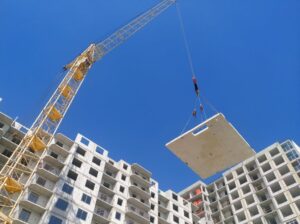
The share of transactions for the purchase of housing on the terms of installments in March 2024 reached 95%, while a year ago the figure was 85%, and in the pre-war period – 70%, follows from the data of the group of companies DIM.
According to DIM, while the share of installments is growing, the rate of full payments on home purchases has fallen to 5%. At the same time last year, full payments accounted for 15% of transactions, and in the pre-war period – 30%.
“The greatest demand among customers are programs of interest-free installments, long-term installments from the builder from 3 to 5 years, installments for the first installment – payment of the first installment within 3 months, the program ‘eOsela’ for ready and under construction apartments, fixing monthly payments for the first year of installments, ‘vacations’ for installments, for example, in the winter months, and other promotions,” – said the marketing director of the group DIM Daria Bedya at the discussion panel DIM Talks.
According to her, as of March 2024, half of the structure of transactions was concluded with the first installment of 20-30% of the cost of the apartment, while a year ago they were only 35%, and in March 2021 – only 15% of the total number of contracts.
Another 20% of transactions today are concluded with a down payment of 10-20%, and only 10% of transactions – with 31-50%, while in the pre-war period this option was more popular (35% of transactions).
According to Bedia, when buying a one-bedroom apartment in 2024, clients more often choose housing with an area of 40-45 square meters, which is in line with the indicators of previous periods. At the same time, apartments with the area of 45-55 square meters have lost popularity after the start of full-scale invasion: transactions for their purchase today account for 5% of the total number against 20% in 2021.
According to DIM, 90% of transactions for the purchase of two-bedroom apartments concern housing with an area of 55-68 square meters, and objects of 70-82 square meters occupy only 10% of transactions, while before the full-scale invasion they occupied 40% in the structure of sales of two-bedroom apartments.
As for three-room apartments, 70% of their sales fall on the most compact variants – 80-85 square meters. m. According to DIM statistics, this trend has only intensified over the last three years.
As reported, in the first quarter of 2024, DIM Group commissioned two objects for 1,060 apartments.
DIM Group was founded in 2014 and consists of six companies covering all stages of construction. To date, it has commissioned 12 houses in six residential complexes with a total residential area of more than 218 thousand sq. m. At the stage of construction – six residential complexes of the category “comfort +” and “business class”: “New Autograph”, “Metropolis”, Park Lake City, Lucky Land, A136 Highlight Tower, Olegiv Podil.

The share of investment transactions in the structure of sales in the primary housing market is about 15%, which is more than twice lower than the pre-war figure, according to a survey of developers conducted by Interfax-Ukraine.
“The share of investment apartments differs in different classes of residential real estate. The average rate of such transactions is about 15%. Since the beginning of last year, the share of apartments under development has remained virtually unchanged, while it has halved compared to the pre-war period,” KAN Development told the agency.
According to the company, the portrait of the investor has not changed significantly, but there are more buyers from the regions and those wishing to purchase multi-room, family apartments.
According to the developer Alliance Novobud, the share of investment transactions in its sales structure is currently on average 15%, while before the full-scale invasion the figure was 20-25% in Brovary and 30-40% in Kyiv.
According to Iryna Mikhalova, CMO of Alliance Novobud, there is a high demand for either finished or highly finished houses, but there is also growing interest in investing in the excavation stage due to the growing shortage of finished apartments.
“The portrait of the buyer has not changed much. Most often, these are people, private investors who are engaged in the rental business or plan to sell real estate by assignment. There are also legal entities that buy apartments in bulk for resale after renovation. They have high hopes for the demand from buyers under the “eOselya” and “eRestoration” programs,” the expert noted.
Kovalska Real Estate also noted a moderate recovery in investment demand. According to Igor Subotenko, the company’s director, the share of such transactions is currently 20% in the comfort class.
“Apartments are bought to save money and to increase the margin of start-finish construction, as the cost of each new project is getting higher,” he explained.
According to the expert, investors are interested in apartments for families of four or more people: zoned one-bedroom apartments of up to 60 square meters, two- and three-bedroom apartments of up to 110 square meters.
The share of investment demand in Intergal-Bud’s sales structure is currently 10-15%, while last year it was 5-10%, and before the full-scale invasion it was 40% or more. At the same time, the portrait of the investor has changed somewhat.
“Before the full-scale invasion, we recorded a considerable interest in primary investment among business owners and representatives of the IT industry. In 2021, young people, 28-30 years old, bought housing to earn money. Now these are people aged 40+, with almost no representatives of the technology and creative industries among them, but many employees and civil servants,” said Anna Laevska, Commercial Director of Intergal-Bud.
According to her, the share of IDPs among investors has also increased, as they invest their remaining savings in square meters to earn money after purchasing residential real estate.
According to Daria Bedia, Marketing Director of DIM Group, the developer’s clients mainly buy housing for themselves, but about 10% of transactions are investment. At the same time, most of the investors are professional, who previously had real estate in their portfolio.
One-bedroom apartments are in the greatest demand in the comfort+ class, while the requested area has decreased by an average of 15 square meters.
The Group is also considering introducing a format of income housing-apartments managed by a professional operator into its projects.
“This is a separate product that we are actively developing. In two of our projects, apartments with hotel services are designed as part of residential development. Among the added value are the best service for owners from well-known operators, the ability to comfortably accommodate relatives and friends in their homes without violating their privacy, and a well-developed internal infrastructure, as the apartments become a center of attraction for additional services: spa, restaurant, coworking, children’s areas, etc.” Bedia explained.
According to Roman Davymuka, CEO of Avalon, developers are actively developing additional services for investment housing.
“People are investing mainly in the long term – if in an apartment, then to make repairs and then receive rental income. We believe that special holistic services from the developer, including repairs, are the future of the product, and the market will develop into fully finished apartments,” he said.
Kovalska Real Estate is considering a turnkey renovation service. It is expected that the cost of repairs will be $400 per square meter. The service is planned to be launched in the new phase of Rusanivska Havan residential complex, the company’s director noted.
According to the press service of KAN Development, the developer has launched the KAN Market service, which allows customers to sell or lease their real estate and manage the full cycle.
For its part, Alliance Novobud is exploring various formats of additional services for investment housing, including the management of both apartments and parking spaces.
“We are considering engaging third-party partners to implement the collaboration, as well as an internal management company,” said Mikhaleva.
Bedia, DEVELOPER, DIM, HOUSING, Kovalska Real Estate, Суботенко

The transition to a regime of managed exchange rate flexibility has not yet affected housing prices in the primary market, but it may change the behavior of potential buyers, and the rise in the dollar in the future may affect construction costs, according to Ukrainian developers interviewed by Interfax-Ukraine.
“We do not expect any sharp price fluctuations in the primary market. Pegging to the current US dollar exchange rate is a standard practice among developers. That is, in case of a significant depreciation of the hryvnia against the dollar, prices for square meters in the national currency equivalent will indeed increase. However, we do not see any reasons for this at the moment,” Anna Laevska, Commercial Director of Intergal-Bud, told the agency.
According to her, in the short term, the cost per square meter will be mainly influenced by the dynamics of real demand and the cost of construction.
At the same time, the rise in the dollar may lead to higher prices for contractors’ services and construction materials, said Dmytro Novikov, marketing director of City One Development.
“At present, we do not see any prerequisites for a rapid rise in prices in the primary real estate market. Even if the dollar rises in value, there will be no significant changes in the primary market in the near future. But it may have an impact in the future: if the cost of construction materials, which are directly tied to the currency, rises, the cost of construction will certainly increase,” he said.
Daria Bedia, Marketing Director of DIM Group, expressed a similar opinion.
“The pricing policy in the primary market is always closely linked to exchange rate fluctuations, as a large percentage of contractor services and the cost of construction materials, for example, are tied to the US currency. If the exchange rate rises significantly, it will create an additional burden on the cost of construction, which will push the price up,” the expert said.
At the same time, the rhetoric about the “rise in prices” against the background of a flexible exchange rate is nothing more than a marketing ploy and an attempt to persuade buyers to buy, she noted.
“There will be no rapid growth in this case, taking into account the constraining factors,” Bedia believes.
In case of a dollar appreciation, developers will be able to slow down the growth of costs only with the help of previously purchased stock of building materials, said Irina Mikhaleva, marketing director of Alliance Novobud.
“We can say for sure that with the further growth of the dollar, the cost of primary materials will also increase, primarily in hryvnia equivalent. The cost of construction will also increase, as manufacturers and suppliers of services and building materials will raise prices. The only way to slow down the growth of costs may be the stocks of building materials that were purchased earlier and are now at the disposal of builders,” she said.
Ms. Mikhaleva noted that the market reaction can be predicted only if the dollar gradually rises, without sharp jumps.
For their part, KAN Development believes that even a sharp fluctuation in the exchange rate will have a minor impact on the housing market.
“Even a sharp fluctuation in the exchange rate, if it affects the cost of real estate, will not significantly affect the housing market. If the hryvnia drops by 10%, it will strengthen later. Government mortgage programs will not be suspended and will continue to be issued in hryvnia. As for new housing, developers will continue to adjust to the market price in dollars. So far, we do not see any factors that could sharply collapse the hryvnia,” the developer commented.
According to the Kovalska Group’s press office, the transition to exchange rate flexibility may have an indirect impact on demand and may slow down the pace of recovery in the real estate market amid a general decline in purchasing power.
“For example, buyers who have savings in another currency and are ready to buy today may postpone their purchase decisions until the exchange rate is “better”, and buyers who are considering purchasing under government and partner programs such as eOselya, preferential mortgages, etc. may go to the secondary market in search of cheaper housing due to “uncertainty”,” the developer noted.
Susanna Karakhanyan, Head of Sales at Greenville Group, also spoke about the likelihood of changing the behavior of potential buyers.
“For those who are now thinking about buying a home, a window of opportunity is opening to invest before the exchange rate gains speed and starts to grow after the commercial one. This situation is likely to accelerate investors who are ready to pay the full price immediately,” the expert told the agency.
In addition, the situation has become unpredictable for those who planned to take out a long installment plan to buy a home.
“While the NBU exchange rate was unchanged for more than a year, investors could clearly calculate their payments. Now the situation will be unpredictable. Therefore, developers will try to take control of the situation: for example, to fix the exchange rate for a certain period in order not to lose a buyer and demonstrate loyalty,” Karakhanyan said.
As reported, on October 3, the National Bank of Ukraine switched to a regime of managed exchange rate flexibility.

Romanian authorities are introducing new rules for housing and food subsidies for Ukrainian refugees starting from May: now the money will be received only by those who have found a job, the EFE news agency reported.
In addition, those citizens of Ukraine whose children go to school in Romania will be able to count on the subsidies.
Under the new rules, the state will no longer pay housing costs to landlords who house refugees, and tenants will receive subsidies directly. Refugee camps will receive subsidies from the state as before. Details of these rules will be made public at a later date, the agency notes.
EFE explains that Bucharest has taken such measures against the background of a significant labor shortage in Romania. More than 3.8 million Ukrainians arrived in the country since February 2022, but the vast majority went to other European countries. According to Romanian authorities, about 110,000 Ukrainian refugees currently remain in the country, but less than 10 percent of them have a work contract.

Housing prices in the European Union fell by 1.5% in the fourth quarter of 2022, writes the Financial Times citing the EU statistical service Eurostat.
Housing became cheaper during the quarter for the first time since 2015. Prices fell in 15 of the 27 EU countries amid tightening standards and rising lending costs.
Denmark (6.5 percent) and Germany (5 percent) recorded the largest price declines.
“In the coming quarters, we expect further deterioration in the price dynamics in the housing market,” the newspaper quotes the words of economist Ani Heimann of S&P Global Market Intelligence.
Over time, a lack of investment by construction companies will limit supply and stabilize prices, Heimann believes.
Data on the state of the market in some countries suggest that in early 2023, housing continues to get cheaper, said FT. For example, in the Netherlands, its value decreased by 1.5% in January-February.

The Ministry of Development of Communities and Territories of Ukraine has updated indirect housing construction cost indicators by region for the first time since the war, the ministry’s press service said, citing Deputy Minister Natalia Kozlovskaya.
The corresponding order Minregion signed on November 17, 2022.
Previously, since February 24, 2022, due to the military aggression of the Russian Federation, state statistics agencies suspended publication of statistical information needed to calculate the indirect cost of construction.
Given the importance and the need to address this issue, according to Kozlovska, the Ministry of Regional Development initiated a change in the procedure for determining and applying the indirect cost of housing construction by regions of Ukraine, which allowed to restore the process.
“During martial law to calculate the indirect cost of construction, the indicators calculated as of January 1, 2022, adjusted for the consumer price index provided by the State Statistics Committee,” – explained the deputy minister.
The updated figures are calculated as of October 1, 2022 and are published on the website of the Ministry.
The indirect indicators of housing construction costs by regions are used to determine the amount of public investment directed to the construction of housing for citizens in need of better housing conditions and state support in accordance with legislative acts of Ukraine, to determine the share of public investment in the construction of such housing and the amount of soft loans granted to certain categories of citizens to address housing issues.